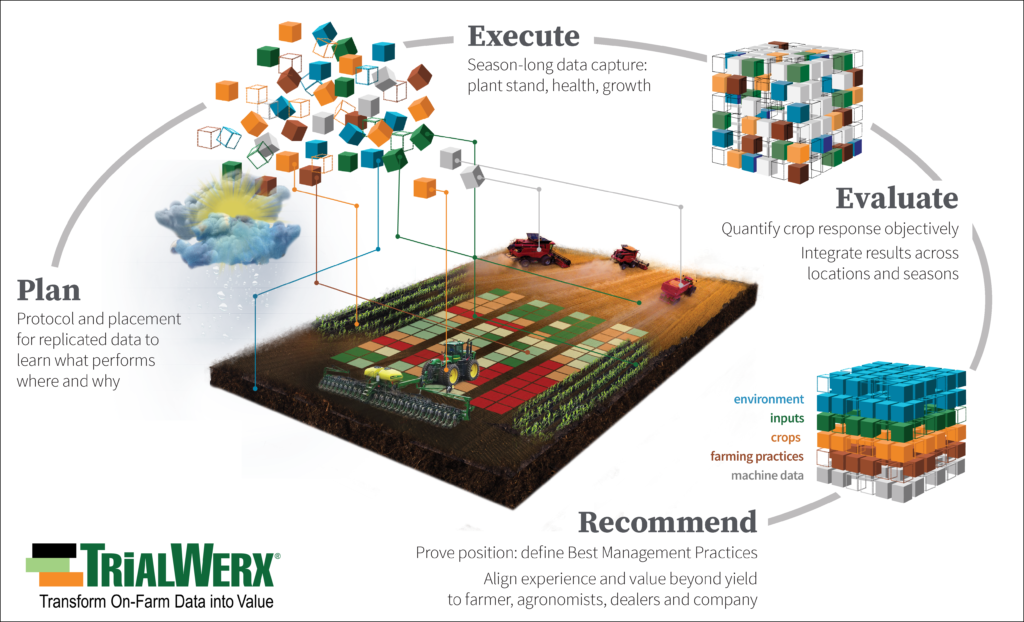Every point in the development process has value. But in late development through launch stages when transferring a new technology to the farmgate, large-scale, on-farm data analysis is so important to build trust in positioning new technologies – especially biologicals. Despite exploding current and future investments into biologicals the last few years, growers still view them as supplemental to what they’re already doing, according to the 2022 Biologicals Survey by CropLife. Not only that, but 41% of those surveyed said the biggest barrier to biological product adoption was lack of trust.
The analysis of performance in large-scale trials is important – along with all the other steps in the development process – to create a solid foundation for start-up companies, just as established multinationals rely on in-depth development of new products. Large teams have staff that can analyze product performance data, but outside perspectives can give essential insights to help make product launches successful. A high volume of data doesn’t deliver a high volume of insights without in-depth analysis, evaluation and comparisons.
Critical learning helps plan the product positioning—not just where it works, but also where it doesn’t perform. Generating a solid performance story with thorough data analysis and Best Management Practices initiates the transfer of information to growers, their dealers and their agronomists. Shifting the focus from yield improvements for the farmer to increased profitability – and proving it through analyzed data – should be the goal in 2022 and beyond.
Technology leaders can take measurable steps to prove their products’ contribution to profitability.
-
-
- Put the right team in place to maximize impact while decreasing risk of on-farm failure
- Be bold in on-farm trial management: Take a step back and try different approaches to deepen replicated data across environments for better defined and quantified results
-
- Planning protocols, selecting standard comparisons, selecting fields and replicating strips for improved analysis of performance
- Supervising execution for timely and accurate applications while collecting data from multiple sources throughout the season
- Evaluating crop responses objectively through intense, in-depth analysis of the multitude of factors
- Defining Best Management Practices—proven product positioning leads to successful use for positive return on investment
- Delivering product validation with growers, their trusted advisors, and the sales channels
-
- Drive confidence and trust with credibility at all levels
-
 Over the past five years, the AgriThority® team in North and South America have supported companies around the world in their product development efforts including late-stage large-scale, on-farm trials. To transform on-farm data into value, AgriThority deploys an intense, in-depth process called TrialWerx®.
Over the past five years, the AgriThority® team in North and South America have supported companies around the world in their product development efforts including late-stage large-scale, on-farm trials. To transform on-farm data into value, AgriThority deploys an intense, in-depth process called TrialWerx®.
Ignacio Colonna, AgriThority Global Director Science and Technology, explains one example of how this can benefit clients, “Over the past four years, AgriThority® has worked with clients on crop phenotyping through novel methodologies, digital image processing and analysis. This led to the development of predictive phenotyping models for crop diseases, and ongoing efforts for other crop characteristics at early and late stages in the crop season. Currently, the TrialWerx® system is being used to develop image-based models for high-throughput phenotyping of new technologies, both crop input and seed genetics, in strip trials. This process allows a significant gain in the amount and quality of information collected from regular field trials.”
For these clients, the AgriThority team provides turnkey management and data analysis complementing a large, well-established team. The benefits range from on-farm trial supervision to ensure the protocol is being followed to then interpreting the data beyond the yield a grower measures.
To tap into the AgriThority native guides, reach out about TrialWerx. This unique process provides in-depth analysis of comprehensive quantitative and qualitative data to improve performance evaluations while it defines value and positions the product for adoption and use.


